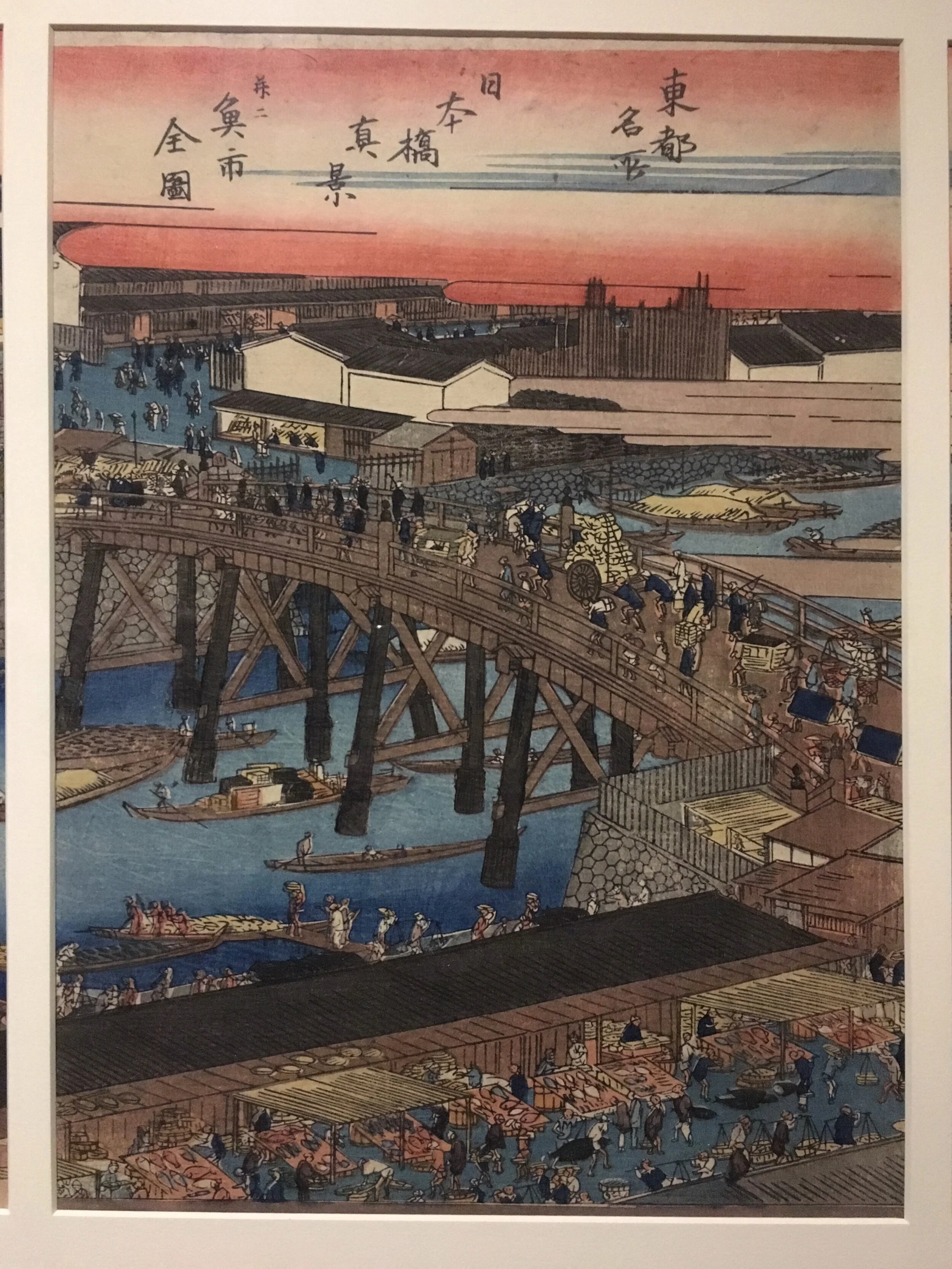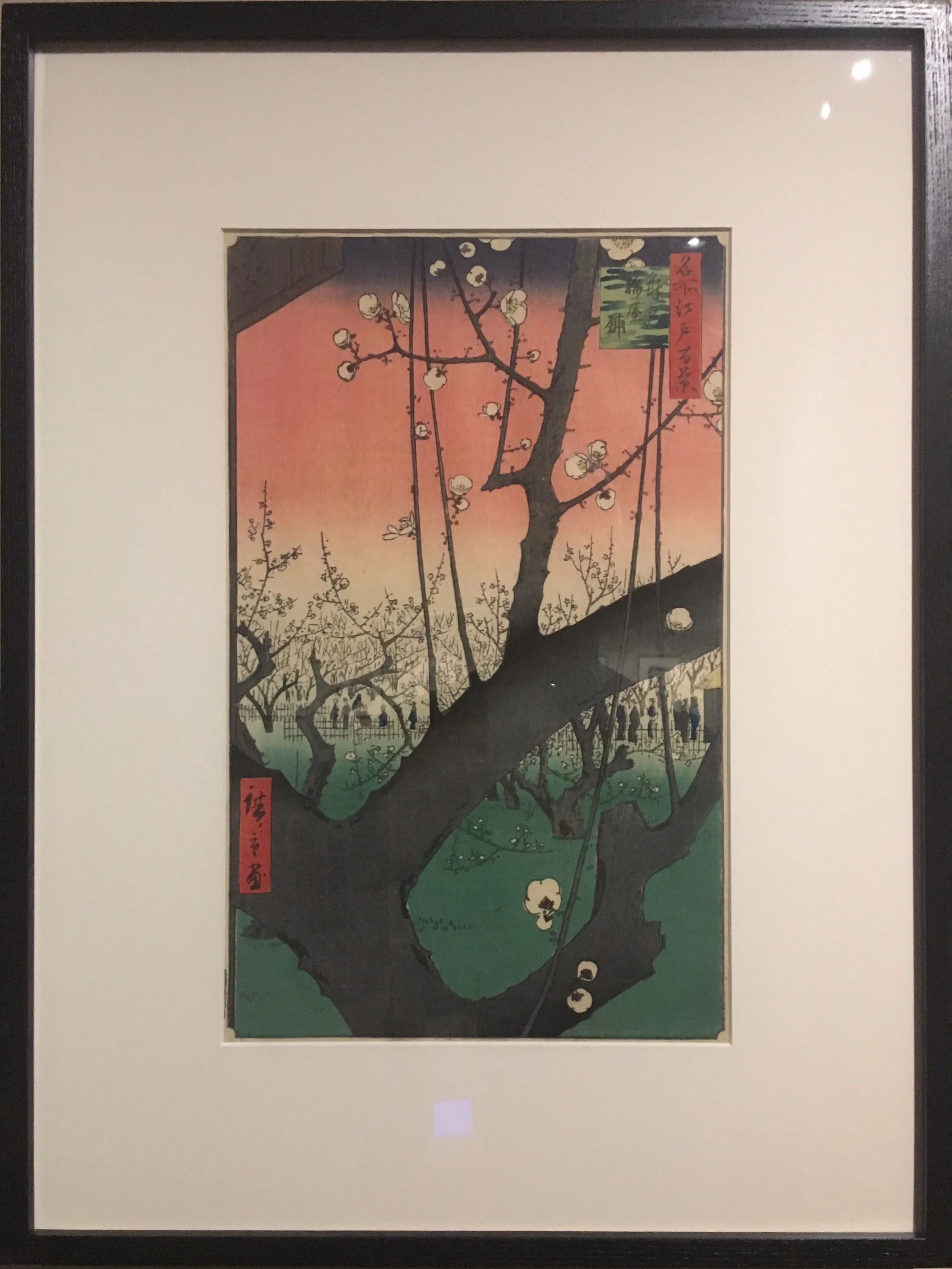Hiroshige (Visions from Japan)
Hiroshige Exhibition Rome 2018
Hiroshige. Visions from Japan
Scuderie del Quirinale, Rome
from 01 March to 29 July 2018
Curator Rossella Menegazzo with Sarah E. Thompson
Author of review: Roberto Matteucci
Click Here for Italian Version
"Living only for the moment, turning our full attention to the pleasures of the moon, sun, the cherry blossoms and the maple leaves, singing songs, drinking wine, and diverting ourselves just in floating, floating."
It is the Richard Lane's translation, reported in an article of The New York Times (1), of a phrase of Asai Ryōi, a Buddhist monk writer of the seventeenth century in Japan.
A quote from the Floating World. It is not a tribute to the pleasures of existence but a Buddhist concept, the perception of enlightenment with normal life.
The Tales of the Floating World are from 1660. Two centuries later, this world will also have an artistic description through the painters of the Ukiyo-e, the Floating World.
Utagawa Hiroshige is the maximum point of the movement.
After the beautiful exhibition of 2009, curated by Giancarlo Calza in Rome at the Museum Foundation, Hiroshige returns to Italian capital in 2018. It is a new path to the Scuderie del Quirinale with the title Hiroshige - Visions from the World curated by Rossella Menegazzo with Sarah E. Thompson.
Hiroshige was born in Edo (nowadays Tokyo) in 1797. Edo after a few years became the most populous city on the planet with about 1.5 million inhabitants. Its expansion is linked to the Tokugawa clan; one of its members was the shōgun, i.e. the political and military lord of Japan. The feudatories, the daimyō, were numerous, divided, small and above all very warlike. Their disputes and wishes for power provoked conflicts and battles. The Tokugawa stifled their ambitions.
They forced them to stay one year in Edo and one year in their fiefdom. When they returned home, their families had to remain in Edo under the control of the shōgun. So, they had to maintain expensive ostentation like building palaces for themselves and their entourage.
The long processions, go and back, were opulent, made up of hundreds of people. The intelligent choice of the Tokugawa had an advantageous consequence; the daimyō spent a lot to go and live in Edo. They even run into debt with the new bourgeoisie, and no longer had money for belligerent ideas.
Edo became an important cultural and economic centre.
The expeditions were made up of dignitaries and samurai. The trips were demanding, lasted many days, carried out in all seasons, pass rivers, cross hills, coast the sea, admire flowers and flowering trees.
When they lived in Edo, they hung out the streets, the markets, the popular districts, the infamous ones, those of the prostitution houses.
Ukiyo-e is the depiction of the intellectual tendency of the time.
Hiroshige is one of the best artists, he narrates this world as a historical and social reading.
Often his lithographs have an element in close-up, such as a carp, or a large tree while the sky and the sea fill the other surface.
Hiroshige, Carp
In lithography the "Carp" the fish occupies the first part, amazing in its beauty. The eye is lively and free, the scales are elegant and multi-coloured. In the other half, there is the "empty": the sea, with pale blue colours, animated by some writings. Above a brilliant sky.
Hiroshige, Crowd Visiting the Benzaiten at Enoshima in Sagami Province on the Occasion of the Exposure of Sacred Images
The same happens with the fascinating triptych the "Crowd Visiting the Benzaiten at Enoshima in Sagami Province on the Occasion of the Exposure of Sacred Images". The sea predominates with its small boats. In the lower part, a ceremony with many people, who are walking towards the sanctuary. The procession, in perspective, reduces the size of the far participants. Refined women in the kimono close the line. All have umbrellas to take shelter from the sun. The colour of the parasols is divided into groups. It is a dynamic and collective creation. Mount Fuji completes the scene in the top. It is far away but the sacred mountain dominates, blesses the religious pilgrimage.
Hiroshige, The Sea off Satta in Suruga Province
Hiroshige's answer to Hokusai's "The Great Wave of Kanagawa" is "The sea of Satta in Suruga Province".
There is a sea storm, and a very high wave - covering three-quarters of the image - is arriving. It is very close to the earth, there is no coast, it will directly hit a hill. The water has a blue colour while the most threatening foam is white. In the background the pure Mount Fuji observes. Below it, there is another sea, calm, placid. It is horizontal between the mountain and the tempest, in a tiny space. The two seas are attached, there is no physical separation, and yet they are totally different. It is the difference with Hokusai. In the Great Wave, the frightening wave is about to crash on a narrow fishing boat. In Hiroshige, there are many, only, in the quiet area. They are fishing, they are sailing in absolute peace. The sign of a mild wind is the sail. For Hiroshige, men choose the most peaceful sea. It is the smallest, while in the vastness there is too much violence, so they avoid it. In Hiroshige's vision, the dangers of nature do not exist.
Hiroshige, True View of Nihonbaschi Bridge. Complete View of the Fish Market Hiroshige, True View of Nihonbaschi Bridge. Complete View of the Fish Market
Another collective scene is the “True View from of Nihonbaschi Bridge. General View of the Fish Market." Another triptych. The middle section is shared obliquely by a big bridge over a river. The image is in four portions. Below there is a large market with many stalls. Visitors are busy buying fish, someone carrying it in bulky baskets. The colour has a brown tone. At the bottom, the avenue turns left onto the bridge to reach the other bank. It is wide, full of crowds, barges are passing below to carry goods. In the other side, there are larger warehouses and fewer people.
In the upper part, the dawn is painted by red and yellow while big ideograms animate it as if they were stars.
Hiroshige, Kameido. The Plum Tree Garden
"Kameido. The Plum Tree Garden” is so beautiful and famous, Vincent Van Gogh painted a copy.
Kameido is an enchanting place in Edo. In Kameido, the blossoming of trees is marvellous.
Hiroshige outlines the dream of that landscape. The representation is in perspective. In the first level, there is a majestic brown tree with white flowers. In the second there is a large clean green lawn. A midline divides the vision, in the path, dozens of people observe the wonderful blossoms. At the top, the sky is red and yellow. It is an explosion of nature.
The exhibition has much more. Besides the carp, there are other fish, crabs, landscapes, mountains, seas, boats, gardens, women, families, sanctuaries, torii, neighbourhoods, crowded streets.
There is all Japan, the suggestive one, the historical one.
(1) https://www.nytimes.com/2004/04/17/style/pleasure-in-the-floating-world.html
#UtagawaHiroshige #Hiroshige #HiroshigeVisioniDalGiappone #HiroshigeVisionsFromJapan #ScuderieDelQuirinale #Roma #RossellaMenegazzo #SarahEThompson #RichardLane #AsaiRyoi #MondoFluttuante #FloatingWorld#ukiyoe #GiancarloCalza #MuseoFondazioneRoma #Edo #Tokyo #Tokugawa #Giappone #Japan #Litografia #lithograph #Carpa #Carp #FollaDiVisitatoriAlTempioBenzaitenAEnoshimaNellaProvinciaDiSagamiInOccasioneDellEsposizioneDelleImmaginiSacre #CrowdVisitingTheBenzaitenAtEnoshimaInSagamiProvinceOnTheOccasionOfTheExposureOfSacredImages #MonteFuji #MountFuji #LaGrandeOndaDiKanagawa #TheGreatWaveOfKanagawa #Hokusai #IlMareDiSattaNellaProvinciaInSuruga #TheSeaOfSattaInSurugaProvince #VedutaDalVeroPonteDiNihonbaschiIllustrazioneGeneraleDelMercatoDelPesce #TrueViewFromOfNihonbaschiBridgeGeneralViewOfTheFishMarket #KameidoIlGiardinoDeiSusini #KameidoThePlumTreeGarden #VincentVanGogh #Kameido #Arte #Art #popcinema #www.popcinema.org





